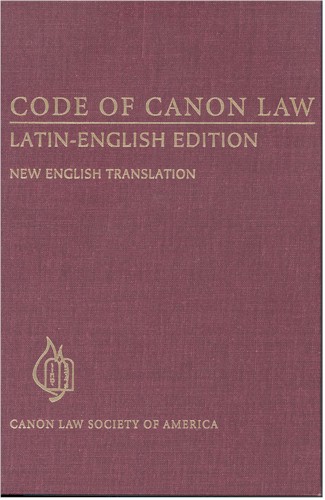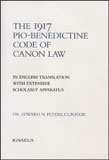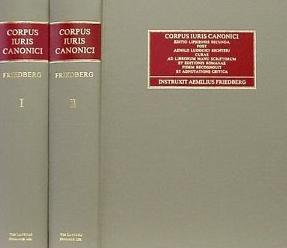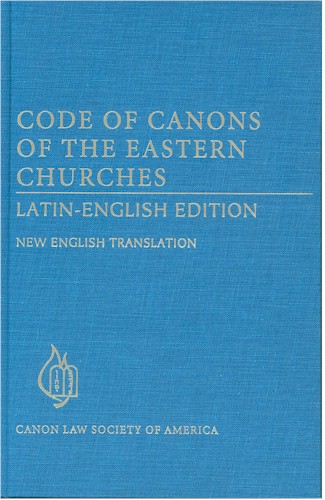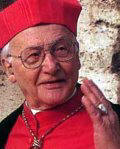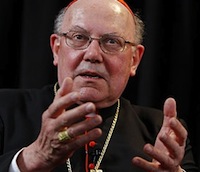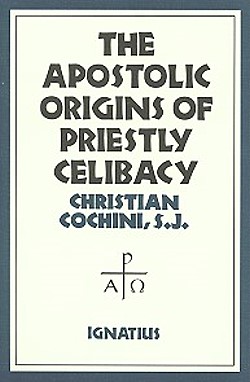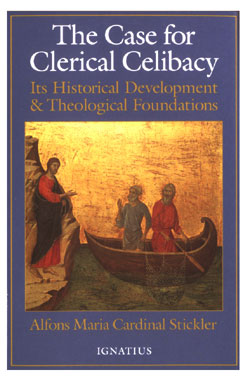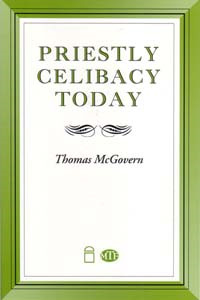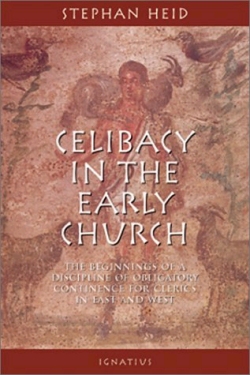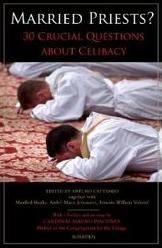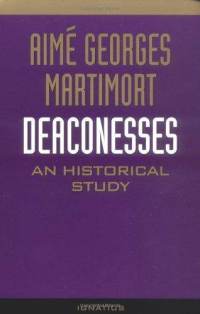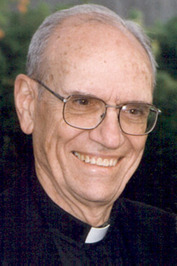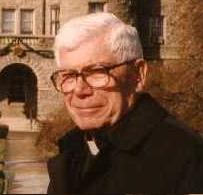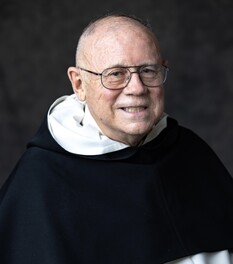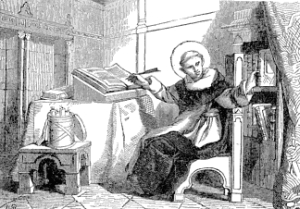|
To work for the proper implementation of canon law is to play an extraordinarily constructive role in continuing the redemptive mission of Christ. Pope John Paul II |
|
17 nov 2022 |
Research links
|
Related
This page was recently reorganized |
|
E. Peters, wbp |
The obligation of perfect and perpetual continence binds all Western clerics |
|
Overview
|
Clerics in the Western Church, including those married, are bound by Canon 277 (and the unbroken and unanimous tradition behind that canon) to observe perfect and perpetual continence. This thesis is not offered lightly. It is firmly grounded in Western law and tradition and, in fact, has withstood every attempt to repudiate it over the centuries, even during periods (such as obtain now) of widespread inadvertence to the requirement.
|
|
Law |
1983 CIC 0227. § 1. Clerici obligatione tenentur servandi perfectam perpetuamque propter Regnum coelorum continentiam, ideoque ad coelibatum adstringuntur, quod est peculiare Dei donum, quo quidem sacri ministri indiviso corde Christo facilius adhaerere possunt atque Dei hominumque servitio liberius sese dedicare valent. § 2. Debita cum prudentia clerici se gerant cum personis, quarum frequentatio ipsorum obligationem ad continentiam servandam in discrimen vocare aut in fidelium scandalum vertere possit. § 3. Competit Episcopo dioecesano ut hac de re normas statuat magis determinatas utque de huius obligationis observantia in casibus particularibus iudicium ferat.
Eng. trans. Canon 277. § 1. Clerics are obliged to observe perfect and perpetual continence for the sake of the kingdom of heaven and therefore are bound to celibacy which is a special gift of God by which sacred ministers can adhere more easily to Christ with an undivided heart and are able to dedicate themselves more freely to the service of God and humanity. § 2. Clerics are to behave with due prudence towards persons whose company can endanger their obligation to observe continence or give rise to scandal among the faithful. § 3. The diocesan bishop is competent to establish more specific norms concerning this matter and to pass judgment in particular cases concerning the observance of this obligation.
|
|
Gravity of
this matter |
The assertion that all Roman clergy, including those married, are bound by the law of perfect and perpetual continence, is important, complex, and not yet resolved by Roman authority. It admits to proper understanding only those able and willing to approach it on the merits. Confidence in the promise of Christ to be with his Church forever, a Church that has faced this crisis before, though perhaps not as gravely as she does now, is in order.
Note A: The most common terminological issue hampering discussion of this issue is the frequent confusing of "celibacy" (the choice not to enter marriage), "continence" (the choice not to engage in sexual, specifically conjugal, relations), and "chastity" (the virtue guiding the proper use of one's sexual faculties). See generally, Peters' Blog, 15 jan 2015, here. These terms are often used imprecisely by unskilled commentators and, even in learned materials, especially over the course of time, have been and sometimes still are used inconsistently.
|
|
Fundamental arguments |
The fundamental arguments that all Roman clergy, including those married, are bound by Canon 277 to perfect and perpetual continence are set out here:
• Edward Peters, "Canonical considerations on diaconal continence", Studia Canonica 39 (2005) 147-180, hereafter Peters "Considerations", pdf here.
Abstract – Analysis of c. 277 indicates that two distinct obligations are imposed on clerics in the Latin Church: sexual continence and celibacy. Continence is presented as the fundamental norm. Although the obligation of celibacy is mitigated for permament deacons, Peters finds no relaxation of the law regarding the fundamental obligation of continence for them in canon law. Testing this conclusion, Peters examines Pio-Benedictine dispositions on celibacy and continence for clerics, post-conciliar norms by which the (permanent) diaconate was restored in the West, and the legislative history of 1983 Code dispositions on the subject. He suggests that these norms maintain the obligation of continence for married permament deacons. Peters then examines various arguments by scholars that support the exercise of conjugal rights by permanent deacons (principally arguments based on c. 4) and concludes that, while these might be potentially applicable to those who received sacred orders without awareness of the requirements of law in this area, they are insufficient in themselves to establish a modification of the traditional canonical obligation of continence reasserted in c. 277. Peters invites the competent ecclesiastical authority to articulate in canonically compelling terms why the obligation of continence should not be applied to married permanent deacons, or to take the steps necessary to assure that formation programs for married permanent deacons conform to the requirement of clerical continence so that candidates for ordination and their spouses can make an informed decision.
Résumé – (Anglais). Une analyse du c. 277 indique que deux obligations distinctes sont imposées aux clercs dans l’Église latine: la continence sexuelle et le célibat. La continence est présentée comme la norme fondamentale. Alors que l’obligation du célibat est mitigée pour les diacres permanents, Peters ne trouve aucun relâchement de la loi pour l’obligation fondamentale de la continence pour eux en droit canonique. Vérifiant cette conclusion, Peters examine les dispositions pio-bénédictines concernant le célibat des clercs et la continence, les normes post-conciliaires par lesquelles le diaconat (permanent) fut restauré en Occident et l’histoire législative des dispositions du Code de 1983 à ce sujet. Il suggère que ces normes maintiennent l’obligation de continence pour les diacres permanents mariés. Peters examine ensuite les quelques arguments de la part d’érudits en faveur du maintien de l’exercise des droits conjugaux par les diacres permanents (principalement des arguments fondés sur le c. 4) et conclut que, bien qu’ils soient potentiellement applicables à ceux ayant reçu les ordres sacrés sans connaître les exigencies du droit en la matière, ils sont insuffisants en soi pour entraîner une modification de l’obligation canonique traditionnelle de la continence répétée au c. 277. Peters invite l’autorité ecclésiastique compétente à articuler en des termes canoniques solides en soi pourquoi l’obligation de la continence ne devrait pas s’appliquer aux diacres permanents mariés ou prendre les moyens nécessaires pour que les programmes de formation des diacres permanents mariés soient conformes à l’exigence de continence cléricale afin que les candidats à l’ordination et leurs épouses puissent prendre une décision éclairée.
Abstractus articuli: Edward Peters, “Canonical considerations on diaconal continence”, Studia Canonica 39 (2005) 147-180. Anglice. Scrutatio can. 277 demonstrat quod duae obligationes et distinctae imponuntur in clericos in Ecclesia latina: continentiam sexualem et coelibatum. Continentia sexualis autem offertur tamquam norma fundamentalis. Etsi obligatio coelibatus mitigatur pro diaconis permanentibus in Codice 1983, praesens auctor tamen non invenit pro illis relaxationem obligationis fundamentalis continentiae in canonibus. Ad hanc conclusionem tentandam, auctor examinat provisiones Codicis Pii-Benedicti in re coelibatus et continentiae clericalis, normas demanantes post Concilii finem quibus diaconatus (permanens) in occidente restituitur, et historiam legislativam 1983 Codicis dispositionum hac in re. Quas normas sustinere obligationem continentiae pro diaconis permantibus etiam uxoratis praesenti auctori persuasum est. Magna cum diligentia examinat auctor argumenta doctorum qui defendunt exercitium iurium conjugalium a diaconis permanentibus (praecipue argumenta ex can. 4) et concludat quod, non obstantibus argumentis fortasse propositis pro illis qui ordines sacros accepiunt inscientes normas legis in re continentiae obligationis, non esse satis in se statuere modificationem obligationis continentiae vindicatae in can. 277. Postremo, invitat praesens auctor ecclesiasticam auctoritatem competentem demonstrare modis canonice cogentibus obligationem continentiae ad instituendos diaconos permanendos uxoratos non applicari, vel, instruere ut Rationes studiorum in quibuslibet regionibus ad diaconos permanentes uxoratos instituendos conforment ad normas continentiae clericalis, ita ut candidati ad ordines necnon uxores suae possint iudicium bene informatum facere.
Note B. The arguments offered in Peters "Considerations" deals with Church discipline and consequently are canonical (and not, say, Scriptural) and therefore liable only to canonical counter-argument. One is free to marshal biblical, historical, and/or pastoral arguments for or against the discipline defended in Peters "Considerations" but one may not present such arguments as either proof or refutation of its canonical assertions.
|
|
Immediate
issues |
The anomalous situation of married men now ordained without personal (or uxorial) consent to their obligation of continence is acknowledged and the exercise of conjugal rights among such persons at present is defended in Peters, "Considerations", 177-178. See also Peters' Blog, 15 jan 2011, here. The issues raised here regarding the obligation of clerical continence are prospective in nature and ask what should be done in the future about the grave disconnect between obvious law and unbroken tradition on the one hand and common assumptions and practices on the other.
The arguments set out in Peters "Considerations" on diaconal continence apply even more strongly to priests, that is, to clerics more closely configured to Christ the High Priest than are deacons and who, among other things, actually perform the Eucharistic sacrifice.
|
|
Questions, objections, and replies |
Following the appearance of Peters "Considerations" and notice of my arguments being taken in the blogosphere a number of questions and objections surfaced. In no particular order some of these materials are treated below.
|
|
Custom does derogate from continence |
Some (including some holding that Canon 277 binds all clerics in the Roman Church to continence) nevertheless wonder whether widespread non-observance of the continence obligation among Roman married clergy derogates from that ancient obligation; specifically some wonder whether “custom” is (or was by, say, late January 2013) applicable against certain obligations set out in Canon 277.
I believe the answer to that question to be No.
Briefly, in this context the word "custom” is canonical and must be taken in its canonical—not its popular—sense if it is to be invoked for canonical ends and no less an authority than Alphonsus Van Hove (1872-1947) warned that “custom” is the canonical topic “intricatissima”. Nevertheless, because “custom” might be invoked against the obligations of Canon 277 by some unawares of what the term means canonically, I venture to explain why a “custom argument" does not avail against the obligation of perfect and perpetual continence for all clerics in the West in my Memorandum of Canon Law (November 2012), pdf here.
|
|
Two 'non-responsive responses' from the PCLT
|
Two letters on Pontifical Council for Legislative Texts stationary dealing with the continence obligations of married deacons were produced in 2011. Neither letter settled this question.
(a) In the first letter, dated March 4, 2011, Abp. Francesco Coccopalmerio, President of the PCLT, responded to a letter faxed him two weeks earlier (see Roman Replies and CLSA Advisory Opinions 2011 at 18-20, pdf here) and, in a single remark, purported to offer a "clarification" of what is, of course, a complex and controversial canonical matter. While the designation of this letter as only a "clarification" indicated that no formal interpretation of Canon 277 was intended some observers took the prelate's remark as settling a controverted canonical point, so I commented on it in my Memorandum of 27 October 2011, pdf here.
(b) In the second letter, dated December 17, 2011, Abp. Coccopalmerio offered an extended "clarification" of the continence obligations of married deacons. The prelate's letter was not immediately released to the public but it was distributed to all US bishops under a cover letter from the USCCB dated 31 January 2012, available on-line here. I commented publicly on the US cover letter, below, but responded only privately to the PCLT letter until such time as it was released to the public. That eventually happened (see Roman Replies and CLSA Advisory Opinions 2012 at 12-14) at which point I made a response in my Memorandum of 16 February 2012, pdf here.
Two points concerning these letters must be highlighted:
First, neither Abp. Coccopalmerio’s second and longer letter nor his brief first, is, or claims to be, an "authentic interpretation" of Canon 277. The authority of the PCLT is set out in ap. con. Pastor bonus (1988) n. 155: "With regard to the universal laws of the Church, the Council is competent to publish authentic interpretations confirmed by pontifical authority, after consulting the dicasteries concerned in questions of major importance." See also Exegetical Commentary (2004) I: 322-323 and CLSA New Comm (2000) 71-73. Abp. Coccopalmerio’s letter was not confirmed—neither ‘generically’ nor ‘specifically’—by pontifical authority and it was sent only to the US bishops. It does not satisfy, therefore, several key requirements of an authentic interpretation of universal law.
Note C: As further evidence that the PCLT letters are not 'authentic interpretations' of Canon 277 the PCLT itself indicated that, in 2011, it had replied to some questions not considered dubia iuris, including a question “concerning permanent deacons in regard to Canon 277” (my trans). Communicationes 43 (2011) 35.
Second, Abp. Coccopalmerio’s letters, whatever their weight, concern only deacons, not priests. My original Studia article on clerical continence focused on married deacons but, while the obligation of perfect and perpetual continence begins at diaconate, the arguments for obligatory continence among married priests—men who are more closely configured to Christ the High Priest and who are more intimately linked to the altar of sacrifice than are deacons—are necessarily even stronger. Therefore, even if some change in the law of continence could be established in regard to married deacons (and recent develops such as Omnium in mentem imply, in some respects, a widening wedge between diaconate and priesthood), nothing, absolutely nothing, in Western law or tradition can account for the abandonment of the obligation of perfect and perpetual continence among married priests.
|
|
Rite of Ordination |
The Rite of Ordination of Deacons (1989) does not require married candidates to promise celibacy or continence; therefore, according to some, married deacons are not bound by celibacy or continence. At least three responses may be offered:
• The obligations of clerical continence and celibacy are canonical in nature, not liturgical, so one must look to canonical sources (chiefly the Code of Canon Law), and not liturgical sources (such as the Roman Pontifical), for their scope and application. The canonical obligation of clerical continence is set out in Canon 277 § 1 and is nowhere lifted for deacons or priests. The canonical obligation of clerical celibacy is set out in Canon 277 § 1 and is lifted for deacons in Canons 1031 § 2, 1042 n. 1, and 1050 n. 3, while that for priests can be dispensed by Rome.
• Just as no express promise of celibacy need be offered by ordinands in order for the matrimonial impediment of holy Orders apply to single men upon their ordination (and to married men upon the death of their wives) per Canon 1087, so too, no formal promise of continence need be offered by ordinands for the obligation of continence to apply to clerics upon ordination per Canons 266 § 1 and 277 § 1.
• The obligations of the clerical state are very many (see, e.g., 1983 CIC 273-289). That only a few of them are emphasized during the Rite of Ordination makes practical sense and in no way implies that those many other obligations that are not expressly recited during the rite are somehow less binding, let alone do they become non-binding.
|
|
Four possible outcomes |
As resolution of the grave disconnect between law and practice regarding the clerical continence in the West four outcomes seem reasonably possible. The Roman Church can:
• reaffirm the unbroken tradition of perfect and perpetual continence for all clerics; or, • reaffirm the continence obligation for all priests but abandon it for married deacons; or, • assert a temporary continence obligation for married priests (and possibly for deacons); or, • abandon any expectation of continence for married clerics (i.e., canonize the present situation).
For more discussion of this point see Peters, wbp Four Options regarding continence and marriage clergy in the West, here. From that page: It is ironic, to say the least, that Western married deacons and priests, despite belonging to the Church that has unquestionably held with near absolute consistency for a celibate (and, even if married, a completely continent) clergy, have adopted an approach to continence that, not only has no support in Western law or tradition, but that fails to satisfy even the mitigated continence expectations of various Eastern Churches. While some are not struck by the fact that, with no express approbation or endorsement by ecclesiastical authority, a dramatic abandonment of Western expectations regarding this important area of clerical life has occurred in so short a time, I think it very important, both for the operation of law and for the stability of the faith community, that such a complete change in fundamental clerical practice either be formally recognized in law if it is genuine or be prudently but firmly removed from practice if it is not. The current continued dichotomy between law and history on the one hand, and assumptions and practice on the other, is incongruous and ultimately unsupportable.
|
|
Some other matters related to married clergy in the West |
The discussion of continence obligations among married clergy occasions wider questions about the place of married clergy in the Roman Church. I outlined some of these questions (such as the confusion caused by, for example, the pleonastic term "permanent diaconate" and the oxymoronic "transitional diaconate") in Edward Peters, "Diaconal categories and clerical celibacy", Chicago Studies 49 (2010) 110-116, available here.
Note D: As it happened, my Chicago Studies article occasioned a very poor reply, namely, Peery Duderstadt, "A Modest Proposal: A Reply to 'Diaconal Categories and Clerical Celibacy'", Chicago Studies 50 (2011) 236-24. While it would have been tedious to discuss all of the many flaws in Duderstadt's essay—let alone to ask Chicago Studies to publish my rejoinders—I felt that some response was in order if only to illustrate what kind of ineptitude is wont to present itself, even in respected venues, as if it were informed refutation of my thesis. My memorandum in reply to Duderstadt is available in PDF, here.
|
|
Other studies of clerical celibacy and continence
Stickler
Cochini
Heid
|
• Thomas McGovern, Priestly Celibacy Today (Scepter/Midwest Theological Forum, 1998) 248 pp., esp. pp. 58-65. Order it here. McGovern's basic text is available on-line here.
• Alfons Maria Cdl. Stickler (Austrian prelate, 1910-2007), The Case for Clerical Celibacy, (Ignatius Press, 1995) 106 pp., B. Ferme trans of Stickler, Seine Entwicklungsgeshichte und seine theologischen Grundlagen (1993). Order English version here. Excepts from Stickler's Case are available on-line here.
• Christian Cochini (French Jesuit, 1929-2017), The Apostolic Origins of Priestly Celibacy, (Ignatius Press, 1990) 469 pp., N. Marans' trans. of Cochini, Origens apostoliques du célibat sacerdotal (1981). ▪ Review: A. Marchetto, Apollinaris 56 (1983) 294-298. Notes: This was a doctoral dissertation directed by Jean Cdl. Danilieu. ≡ Order it here. Cochini biograph.
• Stefan Heid (German priest, 1961-), Celibacy in the Early Church: the beginnings of a discipline of obligatory continence for clerics in East and West, (Ignatius Press, 2000) 376 pp., M. Miller trans. of Heid, Zölibat in der frühen Kirche: Die Anfänge einer Enthaltsamkeitsplicht für Kleriker in Ost und West (1997). Order English version here. ▪ Review: J. Lynch, Studia Canonica 36 (2002) 277-278.
• Roman Cholij, Clerical Celibacy in East and West (Gracewing, 1989) 226 pp., available on-line here. ▪ Review: A. Wilder, Angelicum 67 (1990) 584-585.
• Roman Cholij, “Priestly celibacy in patristics and in the history of the Church” (undated), on-line here.
• Ignace de la Pottiere († 2003), "The biblical foundation of priestly celibacy", on-line here.
• William Cdl Levada, "Celibacy and Priesthood" at (Belo Horizonte, 21 nov 2011), on-line here. Cdl Levada spoke out of “personal conviction, and not on behalf of the Congregation for the Doctrine of the Faith” when he proposed “celibacy and continence as a tradition going back to apostolic times". His thoughtful appeal to history, notably his citations to the Jesuit historian Cochini (along with Alfons Stickler and Peter Brown), are very interesting. |
|
Levada |
Cochini (1990) |
Stickler (1995)
|
McGovern (1997)
|
Heid (2000) |
|
|
• A. Cattaneo, ed., Married Priests? 30 Crucial Questions about Celibacy (Ignatius, 2012) 179 pp.
• Gary Selin, On the Christological, Ecclesiological, and Eschatological Dimensions of Priestly Celibacy in Presbyterorum Ordinis, Sacerdotalis Caelibatus and Subsequent Magisterial Documents (Catholic University of America, 2011) 366 pp., pdf here.
• Anthony McLaughlin, The Obligation of Perfect and Perpetual Continence and Married Deacons in the Latin Church, Canon Law Studies no. 573 (Catholic University of America, 2010) 331 pp., pdf here.
• J. Coppens, ed., Sacerdoce et Célibat: Études Historiques et Théologiques (Gembloux/ Peeters, 1971) 752 pp., Eng. edition, Priesthood and Celibacy (Ancora, 1972) 1023 pp.
• Aimé Georges Martimort, Deaconesses: an historical study (Ignatius, 1986), 268 pp., wherein, at 201: “It is well known that, according to the ancient Latin discipline, priests and deacons who had previously contracted marriage were required, upon ordination, to practice continence but were not required to separate themselves from their wives. … In Rome, in the ninth century, [these wives] received a special blessing … and a special costume was even conferred upon them.” (cit.om.)
This passage is interesting in several respects: an accomplished ecclesiastical historian reports with aplomb that continence was obligatory for married men becoming deacons or priests in the West; there was appropriate solicitude for the wives of clerics lest they be cut off from the spousal support (financial, emotional, etc.) that they had a right to expect from their husbands, and for that matter, indications that married men should not be required to do without the personal assistance of their wives; and, a special blessing and even a manner of dress were conferred on the wives of clergy in recognition that wives too were making a sacrifice consequent to their husbands’ ordination and would benefit by special sacramental support.
|
|
Ryland
Keefe |
• Magdalen Ross, extended blog post "On clerical continence" (18 jan 2011), on-line here.
• John Boyle, extended blog post, "Permanent deacons are obliged by the law of continence", 10 Nov 2010, with updates, on-line here.
• Rev Brian Van Hove, SJ Letters to the editor, Homiletic & Pastoral Review (Apr 2007) 6 and (Mar 2008) 6-7, reproduced here.
• Ray Ryland, "The Gift: a married priest looks at celibacy", Crisis (October 2006), on-line here; Letters to the editor, with responses by Fr. Ryland, appeared in the December 2006 issue of Crisis.
• Donald Keefe, SJ, “Clerical Continence and the Restored Permanent Diaconate” (October, 1998), available from Fr. Van Hove, SJ, on-line here, wherein: "The results of the historical research of Alfons Cardinal Stickler into the apostolicity of the tradition of clerical celibacy and continence, the corroboration of his conclusions by Frs. Christian Cochini and Roman Cholij, and the theological analysis of the intrinsic relation between the sacramental signs of marriage and of priestly orders proposed by Archbishop J. Francis Stafford of Denver at a recent Roman conference, are all in practice controverted by the effective condonation of the non-continent exercise of their orders by post-conciliar married deacons who, having lived in ignorance of any obligation to abstain from conjugal relations after their ordination, have now have been absolved of any obligation to continence and, in fact, if widowed, may apply for dispensation from what has been a diriment impediment to remarriage and, if remarried, continue in the exercise of their orders. This anomalous departure from the ancient tradition of clerical continence appears to have its inception in the discussions of the restoration of the permanent diaconate during the Second Vatican Council. However, it cannot be shown to have been authorized by the Council, whether tacitly or overtly, nor by Pope Paul VI in the documents by which he formally instituted the restored permanent diaconate and permitted the ordination to it of mature married men, nor by the 1983 Code of Canon Law." (cit.om.)
|
|
Mullady's defense of celibacy
Mullady |
Rev. Brian Mullady, op, defended priestly celibacy in Homiletic and Pastoral Review (Feb 2010) 61-62, pdf here. I suggested (14 sep 2011) three emendations to Mullady’s good comments on continence.
First, the obligation of clerical continence (c. 277) does not forbid married clerics from “consummating” their marriages for consummation is a singular act (c. 1061 § 1) that would have been performed by married men and their wives long before they were ordained. Rather, clerical continence requires married clergy to cease exercising their right to sexual relations with their wives after ordination (a consequence reflected by the twice iterated requirement—cc. 1031 and 1050—that wives consent to the ordination of their husbands, lest wives be deprived of the opportunity to exercise their conjugal rights within marriage without their consent). Clerical marriages, in any event, despite the observance of continence after ordination, remain “consummated”.
Second, I would assert less firmly the idea that clerical continence has its origin in the Levitical observances of the Old Testament. I think it better to say that clerical continence finds prefigurement in Levitical (or temporary) continence, certainly, but that the origins or foundations of clerical continence today are rooted in the priesthood of Jesus Christ, as Mullady suggests in the rest of his answer.
Third, it is not so much, I think, celibacy that the Latin Church does not impose on Eastern Churches in union with Rome (indeed, as I have argued elsewhere, there is a growing question as to how much Rome, rhetoric notwithstanding, imposes celibacy on Western clergy these days) but rather, that Rome has not for many centuries expected continence of married Eastern clerics, despite unquestionably requiring it of her own, albeit until recently relatively few, married clerics. The more pressing issue for the Roman Church, therefore, is: to what extent will the near-total, post-Conciliar disregard for the hitherto undoubted obligation of perfect and perpetual continence for Western clergy, including those men married, continue to be ignored? Or, is the obligation simply to be abandoned?
|
|
Other issues, mostly briefly treated
Other materials dealing with Canon 277, likely briefly, cited here. |
• Peters' Blog, 09 jan 2017, here. ▪ Longenecker's essay on practical problems associated with married clergy is useful but largely underscores the need for Rome to address the more fundamental questions of clerical celibacy and continence. > Canon 277.
• E. Peters, wbp Some responses to Dcn. James Russell’s remarks on Canon 277, here.
• Edward Peters, "A note on some misapplications of Presbyterorum ordinis 16", Fellowship of Catholic Scholars Quarterly 34/2 (Summer 2011) 33-35, pdf here. ▪ A mistranslation of a key conciliar text lends misplaced support to those who claim that married clergy must 'honor' both vocations 'equally'. > Canon 277. Marriage. Vatican website.
• Peters' Blog, 26 jan 2013, here. ▪ A married deacon advancing to presbyterate and his wife are doing a praiseworthy thing in announcing their decision to live henceforth in continence. > Canon 277. Cornelius. Four solutions. Spousal consent.
• Edward Peters, my memorandum (27 oct 2011) in reply to an advisory opinion by William Woestman on the phrase "in matrimonio viventibus", pdf here.
• Peters' Blog, 26 jan 2011, here. ▪ Replies to some questions on clerical continence. > Canon 277. Ditewig.
• Peters' Blog, 25 jan 2011, here. ▪ Anglicanorum coetibus does not inform one's reading of Canon 277 because it does not treat of clerical continence and applies only to former Anglicans coming into full communion. > Canon 277.
• Further to Peters "Considerations" at 172-174, my Memorandum (26 feb 2011) discussing the phrase "a certain continence" as it appeared in a 1998 dicasterial document on the formation of deacons, pdf here.
Note E: In the course of its “Basic Norms for the Formation of Permanent Deacons” (1998), the Congregation for Catholic Education recalled its circular letter of 1969 wherein guidelines for the education of deacons were presented. See Congregation for Catholic Education, circ. let. “Come è a conoscenza” [Formation of candidates for the permanent diaconate] (16 July 1969), Enchiridion Vaticanum III, nn. 1408-1412, at 834-837. That circular letter makes no comments for or against clerical continence.
• Further to Peters "Considerations" at 169-171, my Memorandum (19/20 feb 2011) discussing the late modification of what was to become Canon 277 in order to eliminate the possibility that married clergy would not be bound by continence, pdf here.
• Peters' Blog, 18 jan 2011, here. ▪ Replies to some questions on clerical continence. > Canon 277. Ditewig. Josephite marriage. Provost. Celibacy.
• Peters' Blog, 18 jan 2011 (2), here. ▪ Assessing a position based on the alleged consequences of the position is to reverse the proper order of analysis. > Canon 277.
• Peters' Blog, 18 jan 2011 (1), here. ▪ Provost was correct to observe that deacons (and their wives) have an acquired right to conjugal relations but wrong to conclude that therefore Canon 277 did not apply to them. > Canon 277. Kandra. Peters "Considerations".
• Peters' Blog, 17 jan 2011, here. ▪ Canon 277 § 3 does not allow bishops to negate the unambiguous import of the first two sections of the provision. > Canon 277. Peters, "Considerations", 151, 168.
• Edward Peters, wbp Responses to Deacon Pilger's comments concerning diaconal continence, here. ▪ The exchanges with Dcn Pilger included on this page were occasioned by his remarks on diaconal continence in Homiletic and Pastoral Review, a rejoinder to same by Rev. Brian Van Hove (linked above), and my engagement of the issue. > Canon 277. See also a brief follow-up re Dcn Dodge (19 feb 2009), on-line here.
|
|
Concluding thought
|
The Church does not make major decisions hastily. The questions raised by me and others concerning the obligations of clerical continence under Canon 277 (and the unbroken Western tradition behind that canon) are very weighty and require informed resolution. I do not know what that resolution will be. But I do know that many people are looking at one resolution of the question (namely, obligatory clerical continence) and—concluding that its immediate implementation would work an injustice on men ordained without such intentions and on their wives (which it would, of course)—dismissing out of hand that resolution as wrong. Such an approach to legal interpretation, however, is substantively mistaken and methodologically backward: substantively mistaken, in that finding for obligatory continence would not require the immediate cessation of conjugal relations between married clergy and their wives; and methodologically backward in that one should ask first what the law requires and then ask how might behavior be brought into conformity with the law or, if appropriate, how the law might be amended to reflect new values.
|
|
Resources |
1. My remarks on USCCB Committee on Clergy letter of January 31, 2012
The USCCB Committee on Clergy, Consecrated Life, and Vocations recently notified American bishops that it had received from Abp. Francesco Coccopalmerio, President of the Pontifical Council for Legislative Texts, a “clarification” regarding whether married permanent deacons were obligated to observe perfect and perpetual continence per Canon 277 § 1. This marks the second time that Abp. Coccopalmerio has offered an opinion on whether Canon 277 § 1 binds married permanent deacons to continence. The prelate's first letter (4 March 2011) and my response to it are available in pdf here.
The Committee has notified US bishops that, per “observations” formulated by PCLT officials, married permanent deacons are not bound to observe continence. The Committee invited bishops to share the dicasterial response with arch/diocesan officials who might find it useful; since then the conference notification has apparently circulated widely. I saw it a few days ago.
There is little to say about the USCCB notification itself. It does not indicate the reasoning by which dicastery officials arrived at their position and it does not add any observations of its own. If the original dicastery letter (PCLT 13095/2011, 17 dec 2011) becomes public—it is not secret, obviously, but I have not seen it in a public venue yet—I will feel free to comment publicly on it. In the meantime, I will share my responses to the Roman letter with those who already have it and who wish to follow this important, and on-going, issue.
Note F: The dicastery letter was made public and I published my reply to it, as noted above.
2. Pio-Benedictine Law, specifically, 1917 CIC 132 § 1
The obligation of complete clerical continence under Pio-Benedictine law, specifically Canon 132 § 1 thereof, including for the few married Roman clerics of those times, was unanimously upheld by standard commentators. See Peters, "Considerations" at 156-160. Canon 132 arose from many sources as listed by Gasparri in the footnote to the norm. Because it is not easy for non-canonists to search out the sources (fontes) of Pio-Benedictine law I have broken out the sources for 1917 CIC 132 § 1 below. “Friedberg” refers, of course, to his 2-volume edition of the Corpus Iuris Canonici and “Gasparii” refers to his 9-volume Codicis Iuris Canonici Fontes.
Dist. 27, c. 8, Presbiteris (Friedberg I: 100) Dist. 28, c. 2, Decernimus (Friedberg I: 101) Dist. 28, c. 8, Diaconi (Friedberg I: 102) Dist. 28, c. 9, Presbiter (Friedberg I: 103) Dist. 31, c. 1, Ante triennium (Friedberg I: 111) Dist. 31, c. 2, Sacerdotibus (Friedberg I: 111) Dist. 31, c. 3, Episcopos (Friedberg I: 112) Dist. 31, c. 7, Si laicus (Friedberg I: 113) Dist. 31, c. 10, Lex continentiae (Friedberg I: 113) Dist. 31, c. 14, Aliter se (Friedberg I: 115) Dist. 32, c. 1, Cum sacerdotibus (Friedberg I: 116) Dist. 32, c. 2, Multorum relatione (Friedberg I: 116) Dist. 32, c. 4, De illo clerico (Friedberg I: 117) Dist. 32, c. 5, Nullus missam (Friedberg I: 117) Dist. 32, c. 6, Preter hoc (Friedberg I: 117) Dist. 32, c. 10, Eos qui post (Friedberg I: 120) Dist. 32, c. 11, Erubescant (Friedberg I: 120) Dist. 32, c. 13, Placuit episcopos (Friedberg I: 120) Dist. 32, c. 14, Seriatim (Friedberg I: 121) Dist. 33, c. 7, Habuisse (Friedberg I: 124) Dist. 81, c. 19, Ministri alteris (Friedberg I: 286) Causa 27, q. 1, c. 40, Ut lex continentiae (Friedberg I: 1059)
Extra, III, 1, c. 13, Ut clericorum (Friedberg II: 452) Extra, III, 3, c. 1, Si qui clericorum (Friedberg II: 457) Extra, III, 3, c. 4, Sane sacerdos (Friedberg II: 458) Extra, III, 3, c. 5, Diversis fallaciis (Friedberg II: 458) Extra, IV, 6, c. 1, De diacono (Friedberg II: 684) Extra, IV, 6, c. 2, Ex literarum (Friedberg II: 685) Extra, V, 31, c. 4, Clerici (Friedberg II: 836) in Sexto, III, 15, c. 1, Quod votum (Friedberg II: 1053) in Clem., IV, c. 1, Eos qui divino (Friedberg II: 1177) Extravag. Joan. XXII, t. VI, c. 1, Antiquae (Friedberg II: 1212)
Conc. Lateranen. I, c. 3 Conc. Trident., sess XXI, de ref. c. 6 Conc. Trident., sess XXIII, de ref. c. 13 Conc. Trident., sess XXIV, de matrimonio, c. 9 Leo X (in Conc. Lateranen. V), const. Supernae dispositionis, 5 maii 1514, § 34
Innocentius XIII, const. Apostolici ministerii, 23 maii 1723, § 8 (Gasparri I: 585-586) Benedictus XIII, const. In supremo, 23 sept. 1724, § 6 (Gasparri I: 601) Benedictus XIII, const. In supremo, 23 sept. 1724, § 28 (Gasparri I: 608-609) Benedictus XIII, const. Pastoralis officii, 27 mart. 1726, § 3 (Gasparri I: 634) Benedictus XIV, const. Ad militantis, 30 mart. 1742, § 12 (Gasparri I: 725) Benedictus XIV, const. Ad militantis, 30 mart. 1742, § 25 (Gasparri I: 728) Benedictus XIV, const. Etsi pastoralis, 26 maii 1742 § VII, n. 26 (Gasparri I: 748) Benedictus XIV, const. Etsi pastoralis, 26 maii 1742 § VII, n. 27 (Gasparri I: 749) Benedictus XIV, instr. Eo quamvis tempore, 4 maii 1745, § 34 seq. (Gasparri I: 898-899) Benedictus XIV, ep. encycl. Allatae sunt, 26 iul. 1755, § 22 (Gasparri II: 460-461) Gregorius XVI, litt. ap. Cum in Ecclesia, 17 sept. 1833 (Gasparri II: 754) Pius IX, ep. encycl. Qui pluribus, 9 nov. 1846 (Gasparri II: 807) Pius IX, litt. ap. Multiplices inter, 10 iun. 1851 (Gasparri II: 855) Pius IX, litt. ap. Ad Apostolicae, 22 aug. 1851 (Gasparri II: 857) Pius IX, Syllabus errorum, prop 72 (Gasparri II: 1008) Pius IX, const. Apostolicae Sedis, 12 oct. 1869, § III, n. 1 (Gasparri III: 28)
S. C. S. Off. (Ratisbonen.), 22 dec. 1880, ad I (Gasparri IV: 385) S. C. S. Off. , 13 ian. 1892, ad 5 (Gasparri IV: 470) S. C. de Prop. Fide, instr. (ad Archiep. Fogarasien et Alba-Iulien.), 24 mart. 1858 (Gasparri VII: 372)
Pontificale
Pontificale 3. Congregation for the Propagation of the Faith, Non latet (1858)
“Whoever ponders diligently the true tradition of celibacy and clerical continence will indeed find that, from the first centuries of the Catholic Church, if not by a general and explicit law, at least by behavior and custom, it was firmly established that not only bishops and priests, but [all] clergy in holy Orders were to preserve inviolate virginity or perpetual continence”. Quoted by Roman Cholij, “Priesthood and celibacy according to recent Church teaching”, in Congregation for the Clergy, Priesthood: a Greater Love, a Symposium on the Thirtieth anniversary of the promulgation of the Conciliar decree Prebysterorum ordinis (Archdiocese of Philadelphia, 1997) originally titled Sacerdozio: Un Amore Più Grande (1997), at 249-256, at 251, fn. 8.
See Sacra Congregatio de Propaganda Fide, instr. ad Archiep. Fogarasien. et Alba-Iulien. Graeci ritus Non latet Amplitudinem Tuam (24 martii 1858), in Collectanea S. Congregationis de Propaganda Fide seu Decreta, Instructiones, Rescripta pro Apostolicis Missionibus, in 2 vols., (Romae: S.C. de Propaganda Fide, 1907) doc. n. 1158, I: 627-630, at 628; also in P. Gasparri & J. Serédi, eds., Codicis Iuris Canonici Fontes, in 9 vols., (Typis Polyglottis Vaticanis, 1923-1949) doc. n. 4844, VII: 372-376, at 373: "Qui germanam tradtionem de coelibatu ac continentia cleri sedulo expenderit inveniet profecto vel a primis Ecclesiae catholicae saeculis, si non generali et explicita lege, moribus saltem ac conseutudine fuisse firmatum, ut nedum Episcopi et presbyteri, sed ut clerici in sacris constituti virginitatem, vel perpetuam continentiam inviolate servarent." Note: I think all of Non latet, dates from nearly a generation before the Bickell-Funk debate, worth reading. Here is a provisional PDF scan of Non latet until I can secure a better.
4. Gratian (12th century)
The leading examination of clerical continence in Gratian's Decree is: Filippo Liotta, La Continenza dei Chierici nel Pensiero Canonistico Classico: da Graziano a Gregorio IX (Quaderni de Studi Senesi, 1971) 401 pp. ▪ Reviews: C. Munier, Revue d’ Histoire Ecclésiastique 67 (1972) 485-489 (French); J. Brundage, Speculum 48 (1973) 376-377 (English).
|
|
Miscellaneous |
• Phil Lawler, A canonical bombshell, 17 Jan 2011.
• Some 2011 exchanges in the blogosphere, some links expired, most probably of minimal value now:
American Papist I (2); American Papist II (-); Anchoress (3); Deacon's Bench I (-); Deacon's Bench II (7); Deacon's Bench III (2); Deacon's Bench IV (3); Deacon's Bench V (4); Deacons Today I (6); Deacons Today II (18); Nat. Cath. Reporter (1); Sioux City Deacon (4); St. Louis Catholic (4*) Vox Nova (12); WDTPRS (3).
* My four reply posts are no longer visible at St. Louis Catholic. In fact, all that remains there last I checked is the original "logical fallacy" claim made against me, allegedly penned by a canon lawyer who would not admit publicly to his/her remarks. Pity. I am actually getting questions from people who wonder whether I've seen the SLC post and whether I plan to reply! In any case, as I had pointed out at SLC, I responded to the "logical fallacy" argument on-line more than two years ago and in other threads more recently. Might I suggest trying the thread at Deacons Today II where inconvenient replies from those whose views are publicly challenged don't seem to disappear.
• Jorge de Otaduy, in commenting on c. 277 § 1 for the Exegetical Commentary (2004) II/1 at 349 states: "Married deacons, however, are not obligated to keep perfect and perpetual continence and may continue their normal married life" adding that the import of his opinion above required c. 277 § 2 to be modified for deacons (though no modification for them is found in c. 288). Of course, Otaduy offers his remarks as a gratuitous assertions, presenting no arguments for his views. I suggest that they fall for the same reasons that I have set out at length above. Even so, I would have acknowledged Otaduy's position if I had had access to this commentary when I wrote my Studia Canonical article. I did not.
• Unus ex Patribus [in Coetu de S. Hierarchia] animadvertit in historia Ecclesiam fuisse reformatam quando in honorem restituta fuit lex coelibatus. Communicationes XVI: 177.
|
|
Some
apparently expired links
Daly |
• Ignitum Today (March 2013)
• RomeReports.com (Conference News, 8 March 2010), watch for some journalistic imprecision and translation anomalies, but good report overall.
• Brendan Daly, "Priestly Celibacy: the obligations of celibacy and continence for priests", Compass 43/4 (2009) 20-33, available = on-line here.
• My brief reply to comments on Catholic Answers Forum, no. 69, 23 Feb 2009.
• My brief reply to posts on The Deacon's Bench, dated 16 Feb 2009. |
|
|
Materials on this website represent the opinions of Dr. Edward Peters and are offered in accord with Canon 212 § 3. This website undergoes continual refinement and development. No warranty of completeness or correctness is made. Dr. Peters' views are not necessarily shared by others in the field nor are they intended as canonical or civil advice.
CanonLaw.info Homepage & Site Directory / Help support CanonLaw.info / Original Materials © Edward N. Peters |
|
Staging |
|
